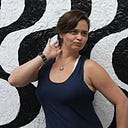20 Days of Goddesses til’ Imbolc
Day 15 — Yemayá (Goddess of Water, Lady of the Ocean, Great Mother, mistress of divination)
She learned how to do divination by watching her husband, Orula, do consults. Women weren’t supposed to do consults but Yemaya was so good at it, her husband made a pact with her that she could use cowry shells to divine.
Whether manifesting as woman or mermaid, Yemaya is always spectacularly beautiful. She can be sexually provocative with a rolling, hip-swaying walk that evokes the sea. Her traditional costume includes seven skirts, that represents the seven seas. Her hair, clothes, and body may be ornamented with crystals, pearls, coral, or tiny bells.
In Africa, Yemaya’s name comes from the Yoruban phrase “Yeye omo eja” that means “Mother whose children are like fish”. Yemayá was the Orisha (Deity) of the Egba nation, a Yoruba tribe who lived near the Yemoja river, in Benin, now known as Nigeria. Due to wars, the Egba migrated and established themselves near the Ogun River, the place from where the Yemayá’s cult left through the slaves to Brazil, Cuba and Haiti. When the Yoruba people were enslaved, their Goddess went with them, sustaining them with life even in the face of the darkest times, in the new world.
When her people were brought to the Americas, Ymoja became known as Yemaya, the “Mother of the Ocean”. As the Yoruba people were not allowed to practice their beliefs in this new world, they merged their deities with Catholic saints, and created a number of new religions — She’s Agwe for Voudoun in Haiti, Iemanjá for Umbanda and Candomble in Brazil, La Balianne in Louisiana Voodoo .
For the Santeria in Cuba, she has three names, depending on which part of her personality you wish to speak with: Yemaya Ataramagwa, The Wealthy Queen Of The Sea, this is her stern persona. Yemaya Achabba, violent, and, The overpowering, Yemaya Olokun who is said to only be seen in dreams — , Within all these differing religions, Yemaya is still revered as a powerful deity.
A more complete definition of Yemayá’s archetype was given by the Umbanda. In this cosmology, she is considered the feminine and receptive principle of fertility and life generation, the primeval womb, the source of primordial water. She incarnates the Great Mother’s attributes of fertility, gestation and motherhood, the phases and cycles of the Moon, the rhythms of the tides. She is the nurturer and protector of women and children, of the animal and vegetal life, the patroness of artists and poets, the lunar inspiration of visions and dreams, the primal and loving Mother who sustains, soothes and mitigates the suffering of her followers and worshippers.
Every year, on New Year’s Eve and on February 2nd, millions of Brazilians, dressed in white, take their offerings and prayers to the sea shore or sail in boat processions.
Colours attributed to Yemaya are blue, silver and white.
Symbols are the six-pointed star, an open shell, the Moon, cowrie shel, land bodies of water, ans, Silver objects, Pearls, Images of mermaids, waterfowl, fish, dolphins, or other creatures of the sea.
Stones are turquoise (and other light blue crystals), pearl, mother-of-pearl and coral.
The trout lily and sea lavender are her flowers, while sandalwood, tea rose, lilac and frangipani are her fragrances. She is also said to be fond of melons, all seafood, lettuce, coffee and white wine.
References:
http://www.aawiccan.org/site/Yemeya.html
http://journeyofayoungwiccan.blogspot.com/2011/07/goddess-yemaya.html
https://goddessgift.com/goddess-info/meet-the-goddesses/yemaya/yemaya-unabridged/
http://wicca-teachings.blogspot.com/2008/09/my-yemaya-shrine-prayer-and-yemaya.html
